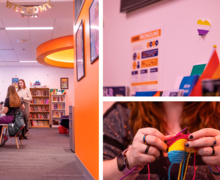Research engineer Lynn Conway discusses innovation, erasure of women in science
Madeline Foreman | Staff Photographer
Lynn Conway spoke at the second University Lectures talk at Hendricks Chapel on Tuesday.
Research engineer and LGBTQ advocate Lynn Conway asked her audience sitting in Hendricks Chapel to imagine that they were in the room with her while she attended the 2013 LGBT Pride Month celebration at the White House.
The room was full of joy, Conway said. She said she could see how far the United States had come since the 1960s in that room. Conway said she tried to envision the struggles and oppressions of other LGBTQ individuals, and through seeing all that suffering had an epiphany:
“We’ve come so far so fast that many of us could now begin uncovering too,” she said.
Conway shared her story to a crowd of more than 50 people at the semester’s second University Lecture on Tuesday. She currently serves as a professor emerita of electrical engineering and computer science at the University of Michigan.
At the lecture, she spoke about the erasure of women’s work in the scientific field. She used her work to revolutionize the way silicon chips were created, as an example.
Conway worked to simplify Very Large-Scale Integration technology, in which an integrated circuit was created by combining large numbers of transistors into a single chip. VLSI had complicated building methods, and certain parts of the chip had to be worked on by hand, she said.
The method Conway developed, which allowed the chips to be designed through computer-based methods, shortened the process and made it easier to do. But she wasn’t recognized within the technology field for her work.
“Down through the decades, no one could explain how the VLSI revolution actually happened. The results were simply taken for granted,” she said.

More than 50 people attended Lynn Conway’s lecture in Hendricks Chapel. Madeline Foreman | Staff Photographer
Conway went on to write a textbook on VLSI, as well as to set up an exploratory “experimental launch” course at the Massachusetts Institute of Technology to teach students the computer-based technology. Soon after, the course spread to 12 other major research universities, Conway said.
By the 1982-83 academic year, the course was being taught at 113 universities around the world, Conway said. The whole time this innovation was happening, though, no one really knew that Conway was behind it, she said.
Scientist Carver Mead, who worked with Conway, received awards and recognitions, from around 1981 to the early 2000s, but not Conway. She said he even received recognitions for innovations that were solely hers.
Conway said her being a transgender woman caused her to feel that she had to work in “stealth mode.” She said she worked behind the scenes.
She was fired from computer hardware company IBM after it was discovered that she was undergoing gender transition. While answering questions from the audience, though, Conway said being fired was the best thing that ever happened to her because she was forced to leave the security of the company.
Conway said that a bigger part of her innovations being covered up was due to what she coined the “Conway Effect.” People do not readily notice innovations, especially ones done by other people, she said. Conway said individuals rely on others to tell them what innovations to accept, reject and even notice.
Credit for accomplishments works in a similar way and is given based on characteristics, like class, money, visibility and prejudice, she said.
After Conway published the story of how she developed her chip creation process in Circuits Magazine, an electronics publication, she said she began to receive more recognition. She said this was evidence that the “paradigm was shifting.”
“It’s possible to trigger large paradigm shifts right out in the open as long as people have no clue what you’re doing,” she said.
After her lecture, an audience member asked if scientists that worked with women whose innovations were ignored, such as Conway’s partner Mead, had a responsibility to speak out.
Conway said there were no “bad guys” in the erasure of women’s work — innovations and the people behind them are often just taken for granted, she said.
“It’s so easy to get upset. And the message I want to leave is don’t get upset,” Conway said. “Look at what is unfolding and see why it’s happening.”
She said that she didn’t want minorities to worry about entering the field of science. Instead, they should enter the field because they are beginning to be seen. Conway compared the process of innovation to a magic trick — saying who did it destroys the magic of it all.
“What is the meaning of powerful if it’s a delusion?” Conway said.
Published on March 27, 2019 at 12:04 am
Contact India: irmiragl@syr.edu





